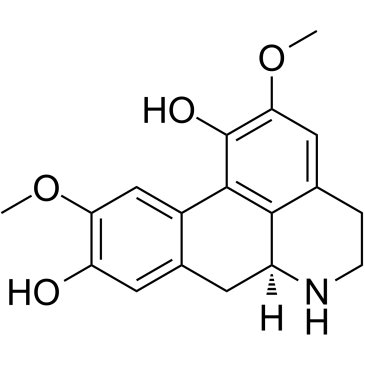| Description |
Norisoboldine is an isoquinoline alkaloid which acts as an AhR agonist, and enhances the function of the adenosine A1 receptor.
|
| Related Catalog |
|
| In Vitro |
Norisoboldine, dose-dependently, inhibits PMA and ionomycin-induced NFAT reporter gene expression in K562-luc cells in the range of 2-50 μM. Norisoboldine also inhibits PMA and ionomycin-induced NFAT dephosphorylation in K562-luc cells and Jurkat cells. Consequently, Norisoboldine suppresses PMA plus ionomycin-induced IL-2 expression in Jurkat cells[1]. Norisoboldine-treated Naive CD4+CD62L+ T cells show a markedly higher frequency of Treg cells, and lead to significant up-regulation of Foxp3 expression. The expression of IL-10 is up-regulated in Norisoboldine (30 μM)-treated naive T cells as compared to the control group. Norisoboldine (30 μM) markedly decreases the levels of IL-17A and IL-17F but not IL-21 in the supernatants of naive T cells. Norisoboldine induces the differentiation of Treg cells, and the expression of CYP1A1 in lymphocytes dependent on AhR. Norisoboldine promotes AhR/Hsp90 complex disassociation and AhR nuclear translocation in lymphocytes[2]. Norisoboldine (10, 30 μM) treatment does not affect the viability of CD4+ T cells, but markedly increase the number of Foxp3+ Treg cells. Notably, when TGF-β is absent, Norisoboldine also induces the differentiation of Treg cells. Norisoboldine increases the protein and mRNA level of TGF-β only at the higher dose of 40 mg, and it slightly affectes the level of IL-6[3]. Norisoboldine can stably bind to AhR, up-regulate the nuclear translocation of AhR, and enhance the accumulation of the AhR-ARNT complex, AhR-mediated reporter gene activity and CYP1A1 expression in RAW 264.7 cells. Norisoboldine inhibits the nuclear translocation of NF-κB-p65, resulting in the evident accumulation of the AhR-NF-κB-p65 complex, which can be markedly inhibited through either Res or α-NF[4]. Norisoboldine inhibits forskolin-induced cAMP accumulation in cultured spinal cord neurons through the adenosine A1 receptor[5].
|
| In Vivo |
Norisoboldine (10 mg/kg, i.p.), alleviates DNCB-induced dermatitis in mice, by the reduction of ear swelling and attenuation of inflammatory infiltration into ear tissue. Moreover, mRNA levels of INF-γ, TNF-α, IL-4 and IL-6 in ears of Norisoboldine-treated mice are reduced by 78.4, 77.8, 72.3 and 73.9%, respectively, compared with untreated controls[1]. The joints from the recipient mice that receive Norisoboldine-Treg exhibit a lower degree of inflammation and attenuated cartilage damage than those received Model-Treg. Moreover, Norisoboldine-Treg more obviously reduces the serum levels of IL-17 and elevates the levels of IL-10 in recipient mice. Mice that receive Norisoboldine-Treg show fewer Th17 cells and more Treg cells distribution in MLNs. Norisoboldine (40 mg/kg) yields a marked decrease in arthritis index and paw swelling. Norisoboldine (40 mg/kg) reduces the inflammation score and bone erosion score to 6.12±0.42 and 0.88±0.13, respectively. Norisoboldine (40 mg/kg) markedly lowers the levels of IgG and IgG2a, which can be largely counteracted by RES[2]. Norisoboldine (20, 40 mg/kg) markedly reduces the symptoms of colitis, the levels of IL-1β and TNF-α, and the activation of ERK, p38 MAPK and NF-κB-p65. Norisoboldine (20, 40 mg/kg) and 5-ASA (500 mg/kg) treatments markedly reduces MPO activity in colons of colitis mice[3]. Norisoboldine (80 mg/kg) decreases formalin-induced activation of extracellular signal-regulated kinase (ERK) and calmodulin-dependent protein kinase II (CaMKIIα) in the spinal cord via adenosine A1 receptor[5].
|
| Cell Assay |
CD4+ T cells are seeded at the density of 2×105 cells/mL into 96-well plates and treated with Norisoboldine (0.1, 1, 3, 10, 30, 60, 100 μM) for 68 h. Then, 20 μL of MTT solution (5 mg/mL) is added, and further incubated for 4 h. Subsequently, the supernatants are removed and the formazone crystals are dissolved using 150 μL of DMSO. The optical absorbance at 570 nm is read with a Model 1500 Multiskan Spectrum Microplate Reader.
|
| Animal Admin |
Briefly, mice are placed on a 50°C hotplate, and the time between placement and shaking or licking of the paws or jumping is recorded as a response latency. The cut-off time is 60 s to avoid tissue damage. Animals are screened before experiments, and the animals whose latency is between 10 and 30 s are then randomly divided into five groups: vehicle group, Norisoboldine (20 mg/kg) group, Norisoboldine (40 mg/kg) group, Norisoboldine (80 mg/kg) group and morphine (4 mg/kg) group. After administration of drugs, the latency of each mouse is tested again.
|
| References |
[1]. Gao S, et al. Norisoboldine, an alkaloid from Radix linderae, inhibits NFAT activation and attenuates 2,4-dinitrofluorobenzene-induced dermatitis in mice. Immunopharmacol Immunotoxicol. 2016 Oct;38(5):327-33 [2]. Tong B, et al. Norisoboldine, an isoquinoline alkaloid, acts as an aryl hydrocarbon receptor ligand to induce intestinal Treg cells and thereby attenuate arthritis. Int J Biochem Cell Biol. 2016 Jun;75:63-73 [3]. Lv Q, et al. Norisoboldine ameliorates DSS-induced ulcerative colitis in mice through induction of regulatory T cells in colons. Int Immunopharmacol. 2015 Dec;29(2):787-97 [4]. Wei ZF, et al. Norisoboldine, an Anti-Arthritis Alkaloid Isolated from Radix Linderae, Attenuates Osteoclast Differentiation and Inflammatory Bone Erosion in an Aryl Hydrocarbon Receptor-Dependent Manner. Int J Biol Sci. 2015 Jul 17;11(9):1113-26 [5]. Gao X, et al. Norisoboldine attenuates inflammatory pain via the adenosine A1 receptor. Eur J Pain. 2014 Aug;18(7):939-48
|


